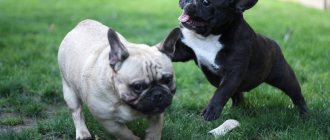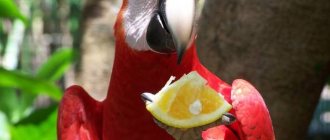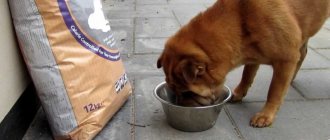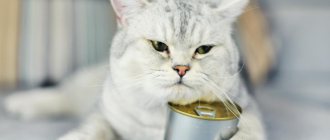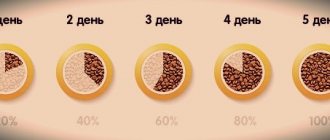Breed Features
Toy Terriers are small but very energetic. A small portion of food should provide your pet with:
- proteins (proteins);
- fats;
- carbohydrates;
- vitamins;
- minerals.
When composing a diet, it should be taken into account that the stomach of an adult dog can optimally accommodate the volume of one tablespoon. A puppy's is much smaller. Of course, the stomach is a muscular organ that can stretch and increase several times, but is this good?
Important! When feeding a puppy, overeating should not be allowed. A low content of energy substances per serving will be accompanied by a constant search for food and an increase in the volume of food eaten. Excessively high-calorie feeding is also unacceptable.
The most energy-rich fats and carbohydrates, especially fast ones (sugars). For a carnivore, especially small breed dogs, there is no need for large quantities of such components.
Caring for a toy terrier puppy - hygiene
Many owners are interested in how to care for a female terrier puppy, or how to care for a male terrier puppy. However, the care and hygiene of puppies does not differ by gender. The differences between a girl and a boy puppy are only in character and behavior - the former are more obedient, affectionate and calm, the latter are more active and playful.
A toy terrier puppy, both male and female, needs to carry out hygiene procedures:
- Clean the eyes daily from secretions with a cotton pad moistened with boiled water;
- Regularly inspect the ears for dirt and clean them if necessary.
- To cut claws regularly, starting from 10 days of age, our other article (How to cut claws) will tell you how to do this.
The toy terrier needs to be bathed rarely - once every six months; as for brushing the teeth - you can start doing it after changing baby teeth to molars. However, if you wish, you can brush your baby teeth once a week; the procedure will not harm your pet in any way; everything about brushing your teeth can be found here.
Choosing a place to eat and dishes
Each owner solves this issue in his own way. When organizing a “dining room”, you need to consider several points.
The feeding area should be:
- light;
- secluded (a dog having lunch should not disturb the household and they should not disturb it);
- easily accessible for both the animal and the owner;
- equipped with a easily washable surface;
In small apartments, the puppy’s feeding place is determined in the kitchen. In this case, the doors are left constantly open, this will provide free access to a bowl of food and water. If the area allows and the dog has its own “room”, then the feeding place will be equipped in it. The distance from the resting place to the bowl should be significant.
When choosing dishes, you should take into account that the full amount of food should occupy only half the volume of the bowl. The dishes should not be allowed to:
- moved;
- capsized;
- jumped up while eating food.
The material from which the bowl is made must be food-grade, high-quality, and durable. Bowls for water and food should be nearby, but not interfere with each other. For this breed there is no need to set up a feeding area at higher elevations. If the owner intends to feed the puppy “from the table,” there should still be room for a bowl. Initially, it is necessary to accustom the dog to it. In the future, this will make it possible to understand that the dog is hungry (when approaching the bowl and sniffing).
Caring for a toy terrier puppy - place equipment
Before bringing a toy terrier puppy into the house, you need to take care of a place to rest, which should be installed in a warm living room, away from drafts. In the chosen place you need to install a bed - cover a small mattress with oilcloth and a clean, warm diaper, which must be changed regularly. The best option is a soft, high-quality house made of durable fabric. You should not save money by purchasing a low-quality product - toy terrier puppies are very active and are capable of breaking a fragile structure in a short time.
Having brought the puppy home, you need to allow him to get acquainted with his new home - show him his place, allow him to carefully inspect the room. Most Toy Terriers easily adapt to changes in environment. However, if the puppy looks scared - it is trembling, hid, whining in a corner, you should calm it down. You need to take the pet in your arms, offer some food, boiled meat, it is quite possible that the baby is tired and needs to sleep. Also, you should not carry the animal for a long time or often, the terrier will quickly get used to it and will start asking to be held all the time.
What to feed a toy terrier puppy
When choosing one or another feeding diet, for this dog the issue of savings and pricing policy will not arise, since she does not eat much. This makes some things easier.
When choosing a feeding method, you need to consider the following aspects:
- usefulness for the animal;
- practicality;
- convenience.
After weighing everything, you can give preference to any particular type, or combine feeding.
Natural diet
A dog is a predator, a carnivore. Her body needs food of animal origin:
- milk and dairy products;
- meat, bones and offal;
- eggs;
- fish.
What to feed an adult toy terrier?
If you decide to feed your pet natural products, you must remember that his daily diet should include:
- meat (raw veal, lamb or beef, boiled turkey or boneless chicken, boiled sea fish fillet);
- boiled eggs and offal (kidneys, heart, liver) no more than once a week;
- cereals (buckwheat, rice, oatmeal, sometimes corn);
- boiled, stewed or fresh vegetables; you can dress this salad with a drop of vegetable oil;
- fruits (apples, bananas);
fermented milk products (kefir, low-fat cottage cheese, fermented baked milk). It is better not to give milk to adult animals to avoid stomach upset.
Ready-made feed
Those specialists who have dealt with laboratory tests of feed can authoritatively state that the content of substances in feed does not correspond to what is written on the label. Unfortunately, manufacturers are well aware of how dry food testing works. Since it is not always possible to measure the quantitative composition of the substances stated in the recipe.
Both “simple” manufacturers and well-promoted product brands are guilty of inconsistency in composition. Very often, feed does not contain the required amount of vitamins and microelements, and expensive natural proteins are replaced with artificial amino acids.
High temperatures during production “kill” even heat-stable vitamins. Consequently, such food cannot fully provide the body with everything it needs.
When choosing food, you cannot rely on someone else’s opinion and experience. The food may be suitable for one dog, but cause pathology for another.
In any case, when deciding to feed dry food, you should give preference to:
- professional;
- designed for small breeds;
- labeled (indicating the composition, standard, date of production, address of the manufacturer).
Advantages
Without a doubt, feeding ready-made food is easy. If decent food is found and the puppy is cheerful, energetic, has good growth, and has no problems with the skin and mucous membranes, then it can be used.
Disadvantages of ready-made feeds
The disadvantages can be listed as follows:
- uncertainty of composition;
- imbalance of components;
- even expensive food contains preservatives and emulsifiers, which can cause pathology in the body;
- frequent replacement of natural ingredients with artificial additives.
Feeding
A puppy's diet should first of all be balanced. It must contain:
- carbohydrates;
- proteins;
- fats.
At the same time, only the freshest foods can get into his bowl. If the puppy left some of the food, it must be taken away. This will avoid stomach problems and, importantly, will become an important educational moment.
It is important not to forget - unlike a person, a dog does not need any flavoring additives, so there is no need for food:
- salt;
- season with different spices, etc.
The puppy should always have the freshest water in a separate bowl. It needs to be changed at least twice a day. Waiting until he drinks it all is unacceptable - very often dogs refuse contaminated or stale water.
Puppies require vitamins and minerals to grow. They are not contained in sufficient quantities in products, for this reason you should use various complexes made specifically for dogs. They are easy to buy at a veterinary pharmacy. It is important here to strictly follow the dosages indicated in the instructions - an excess of vitamins is no better than a deficiency.
What is the right way to feed a toy terrier puppy? This may surprise many, but this breed comes from a wolf, which means that its representatives naturally have an excellent appetite.
Mixed feeding
Experienced dog breeders increasingly prefer a mixed type of feeding. If you take a natural diet as a basis, and sometimes “pamper” your dog with dry food, you can better balance the diet.
When offering dry food to your puppy, monitor his reaction. If eaten willingly, they can be included in the diet, but should not be abused.
Dry food can be temporarily introduced into the diet if the dog is traveling. In this case, you need to “check” them in advance for palatability and non-allergenicity.
Sample menu by age
Initially, the puppy suckles from its mother up to 12 times a day. Further, the multiplicity gradually decreases. When artificial feeding, the regimen should also be followed depending on age.
Feeding up to a month
If there are not many puppies in the litter, and the female feels well, then the milk will last up to 3-4 weeks. If maternal feeding is not enough, then this will be visible in the puppies. The cubs will be in constant search, and the bitch will constantly run away. This signal should be perceived as the beginning of feeding.
Puppies are offered warm, slightly sweetened milk with the addition of chicken egg yolk. You can start with 10-20 ml 4-5 times a day. Careful observation of behavior, growth and development will tell you the frequency and quantity.
When offering fresh cottage cheese and minced boiled meat, you should start with 5-6 g. No more than one product is introduced into the diet daily.
Attention! Puppies should not go hungry.
Age group 1 – 2 months
From this age, boiled fish, coarsely ground meat and boiled bone can be introduced into the diet.
The puppy gradually independently determines its taste preferences. However, this does not mean feeding just one favorite product. The more varied the menu, the more balanced the feeding.
The norm is 1-2 tablespoons with a frequency of 5-6 times a day.
Age group 2 – 4 months
From this age, we reduce the frequency of feeding to 4 times a day. The ration content remains at the same level. Raw cow's milk can be gradually removed. Yogurt should take its place.
4 – 6 months
The frequency is gradually increased to 3 times a day. The amount of food in the plate increases depending on the appetite and state of the animal’s body.
From 6 months to 1 year
At this age, the toy terrier can already be fed 2 times a day. The total amount is 1-2 tablespoons per feeding. This amount must include at least 3 components (for example: cottage cheese, meat, fish).
Tastes and preferences are already fully formed. The puppy is accustomed to the bowl. If he is energetic enough and constantly in search of food, increase the calorie content slightly by adding meat, sour cream and fatty fish.
General rules when choosing a toy terrier puppy.
In this article we will not talk about the cost of puppies, that’s all later. The main thing now is to choose a puppy based on your goals.
So, the breed standards established by the Fédération Cynologique Internationale in a commonly understood language:
- The baby's appearance should remind you of a little deer. The same long legs and deep chest. Even a two- to three-month-old dog is distinguished by a pronounced transition from the chest to the tummy.
- look at the puppy from the side - the dog should look like a square. The length of the baby should be the same as the height at the withers.
- the chest or paw may be decorated with a small white spot. No large stains. And if you and your pet are going to take only first places at all shows, then choose a puppy without spots.
- When choosing a male, inspect the testes.
- Toy's eyes should be convex, not bulging. Such eyes in a baby indicate a large fontanel and increased intracranial pressure.
- inspect the puppy’s mouth, pay attention to the correct bite.
- the back is straight, the legs are long, the withers are higher than the butt - if you have to choose, then only such a handsome man.
What you should pay attention to when choosing a dog:
- The baby must be ten weeks old or older.
- The animal has been vaccinated twice and the baby has passed the quarantine period.
- The breeder has created a veterinary passport, which contains vaccination marks.
- There are no bald spots, bald spots or marks on the Toy's coat. Whatever they tell you about the shedding of toy terriers, do not believe it. During the period of active growth of the puppy, from three months to six months, the dog’s skin may be slightly visible through the fur on the dog’s head. But this does not mean that any part of the toy’s body can be without hair.
- the puppy should look healthy, and this is what they say - clean eyes without discharge, trimmed claws, clean ears and a well-groomed anus.
- The activity and playfulness of a baby of this breed also indicates the dog’s healthy body.
When choosing a puppy, pay attention to the conditions in which dogs are bred and be wary if:
- decorative dogs are kept in cages.
- They don’t show you the puppy’s parents or even show you their photographs.
You can relax if you are introduced to the puppy’s pedigree and given the little toy’s metric in your hands.
Advice
Serious nurseries even give out a metric for defective toy terrier puppies that says o.
An honest breeder will not praise all the puppies of the same litter to you as being suitable for showing or breeding.
Disadvantages are inherent in everyone, both people and dogs, even as small as our terrier. It also happens that a dog does not have a marriage according to the standard, and they are not suitable for performing at shows or for breeding. There are a lot of small nuances, from appearance to character. For ordinary people who want to choose a miniature four-legged friend for themselves, these subtleties are little understood and indistinguishable. The breeder, if he is decent, will advise you to choose a puppy for a specific purpose, or will remain silent about the dog’s shortcomings. Which could further cast doubt on his reputation.
A little bit of terminology that you will encounter when you start choosing a toy terrier:
- PET class. For those who choose a dog “for themselves”. Don't think that PET is a waste. Yes, there are some shortcomings that the breeder sees and understands that in the future such a dog should not be expected to win in the rings or produce offspring with high standards. That's why he sells such babies as PET-class.
- BRID class. This includes toy terriers, mainly girls, who are not suitable for exhibitions. Moreover, for various reasons, including due to temperament. Of course, they will be able to take part in the show, but they are unlikely to enjoy it. By standards, there are no complaints about dogs of this class. Means what? This representative of decorative dogs is suitable for breeding.
- SHOW class. The name of the class speaks for itself. A sonorous, thin, graceful toy terrier with a doll's head, healthy, both physically and mentally, was born with the desire to participate and win in exhibitions and shows. Even as a puppy, such a dog stands out both in appearance and in character.
Vitamins and supplements
The condition of the skin, fur, mucous membranes and teeth is an indicator of the dog’s health. If the puppy is playful, energetic, and has constantly formed fecal masses, then there is no need for vitamins and supplements.
If the slightest pathology is detected, you should consult a veterinarian. A vitamin preparation is a medicine and should be prescribed by a specialist based on the results of the examination and tests performed.
Water
There should be a bowl of water next to the food bowl. Even if there is no food, water should always be in the bowl.
Water for a dog should be:
- fresh (change 2 times a day);
- clean;
- drinking.
There is no need to boil water.
You need to monitor your puppy's drinking habits. Low water consumption, as well as increased thirst, may indicate pathology.
Important! At the slightest deviation in one direction or another, you should seek advice from a specialist.
What to feed a toy terrier at 2 months
Below you can see the approximate diet of a puppy at the age of eight weeks with six feedings a day:
- Cottage cheese diluted with kefir.
- Finely chopped meat (beef, veal).
- Milk porridge (well boiled).
- Boiled meat with vegetables.
- Boil the meat with 1/3 teaspoon of vegetable oil.
A puppy's very first food is mother's milk. As a rule, after the birth of a baby, the question does not arise: “What to feed a toy terrier puppy?” He usually stays with his mother for 2 months. Until the age of three weeks, mother's milk is quite enough, and then the puppies begin to be fed, giving them a pea of beef three times a day.
To do this, finely scrape the meat from the frozen piece and warm it to room temperature. In addition, at this time the baby should receive one ball of low-fat fresh cottage cheese. When we talk about what to feed a toy terrier puppy, it is important to remember that the puppy cannot be separated from its mother until it is two months old.
Prohibited Products
There are foods that are not acceptable as dog food:
- fatty pork;
- raw chicken;
- smoked meats and sausages;
- freshwater and any raw fish;
- ready-made sauces (mayonnaise);
- fried foods (cutlets, etc.);
- pasta and flour products.
Taking into account all the nuances and characteristics of the breed, you can easily create a feeding diet and provide the puppy’s body with the necessary nutrients.
How to raise a toy terrier puppy
Toy terriers at any age are energetic and active; in addition, these dogs are cunning and are able to take advantage of any situation. So, looking at the owner with sad eyes, the puppy can beg for sweets, which are strictly contraindicated. Therefore, in some situations it is worth showing strictness to the toy terrier.
The puppy should immediately be made clear what actions are not permissible. To do this, you can use a standard training scheme - repeated repetition, encouragement and punishment (only a strict tone can be used as punishment).

